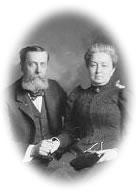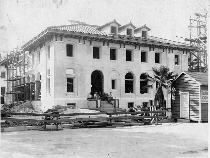Museum of Riverside

History of the Museum of Riverside
By 1900, Riverside had become one of the premiere winter resort communities in the nation. Surrounded by 20,000 acres of Washington navel orange groves, Riverside was a center for agricultural innovation, bringing the revolution of corporate capitalism to the southwestern United States through the modern citrus enterprise.

Located in the broad, inland valley of the Santa Ana River in Southern California, Riverside was among the wealthiest communities per capita in the nation. The University of California Citrus Experiment Station (later the University of California, Riverside) established a tradition of groundbreaking scientific research. Riverside’s renowned Mission Inn Hotel, with its eclectic combination of architectural and decorative arts styles, attracted some of the country’s leading entrepreneurs in search of recreational, aesthetic, and business opportunities. Riverside became a magnet for prosperous, educated practitioners of the Arts and Crafts Movement in the West.
 The Riverside Municipal Museum (Museum) opened in the basement of City Hall on December 12, 1924, when the widow of National Biscuit Company (NABISCO) magnate Cornelius Earle Rumsey donated his collection of Native American artifacts to the City of Riverside.
The City Council adopted an ordinance on August 27, 1925, amending the City Charter and establishing a
municipal museum. (The current ordinance states that, "All collections and exhibits of the Museum shall generally reflect but shall not necessarily be limited to the specific interpretations of the history, natural history and anthropology of the City and County of Riverside and the immediate environs of southern California.") From 1924 on, the collections grew, typically through donations
from prominent citizens and organizations, contributing to Museum holdings in the disciplines of local history, natural history, and anthropology.
The Museum remained in the basement of the old City Hall building on Riverside’s Seventh Street (now Mission Inn Avenue)
until 1948 when it moved across Orange Street into the former Post Office and
Federal Building it occupies today.
The Riverside Municipal Museum (Museum) opened in the basement of City Hall on December 12, 1924, when the widow of National Biscuit Company (NABISCO) magnate Cornelius Earle Rumsey donated his collection of Native American artifacts to the City of Riverside.
The City Council adopted an ordinance on August 27, 1925, amending the City Charter and establishing a
municipal museum. (The current ordinance states that, "All collections and exhibits of the Museum shall generally reflect but shall not necessarily be limited to the specific interpretations of the history, natural history and anthropology of the City and County of Riverside and the immediate environs of southern California.") From 1924 on, the collections grew, typically through donations
from prominent citizens and organizations, contributing to Museum holdings in the disciplines of local history, natural history, and anthropology.
The Museum remained in the basement of the old City Hall building on Riverside’s Seventh Street (now Mission Inn Avenue)
until 1948 when it moved across Orange Street into the former Post Office and
Federal Building it occupies today.
New Home of the Riverside Municipal Museum, 1948
 The
old Post Office and federal building is a Neo-Classical-style structure, with a
cornerstone bearing the date 1912. The main exhibitions and many supporting
functions were long housed in this building.
The
old Post Office and federal building is a Neo-Classical-style structure, with a
cornerstone bearing the date 1912. The main exhibitions and many supporting
functions were long housed in this building.
Expansion and Professionalization, 1961-1978
During the early 1960s and 1970s, the Museum broke out of its traditional role as a repository of donations from City notables. New exhibitions and community-oriented programs, made possible by substantial involvement of the Junior League of Riverside, brought about an expansion of the Museum to all floors of the building. The Museum was remodeled between 1962 and 1965. Staff expanded from three to twenty-eight paid positions. World famous naturalist and Riverside resident Edmund C. Jaeger served as Curator of Plants. His presence inspired the Junior League to fund the creation of the Nature Study Lab facility in his name. Accreditation by the American Association of Museums (AAM) came in 1972, with the visiting committee’s report citing the Museum as a model institution of its type.
Creation of the Riverside Museum Associates
The Riverside Museum Associates was a product of the Junior League’s involvement in Museum programs. The Riverside Museum Associates (RMA) is a 501(c)(3) membership organization and a California non-profit corporation; it was officially incorporated as a private supporting group for the Museum in 1963. The RMA came to form the basis for continuing community support for the Museum, providing volunteer services as well as financial assistance. In 1969, the RMA and the Junior League helped expand programs through the purchase of an 1891 Queen Anne-style home, today known as "Heritage House" (located on Magnolia Avenue, six miles from the downtown location). The Museum eventually fully restored the home for use in local history interpretation as a house museum, and the RMA transferred title to the property to the City.
Name Changes and an Ambitious Future
In 1987, the National Park Service placed the main museum building and Heritage House on the National Register of Historic Places. In 2004, the Museum acquired Harada House, a National Historic Landmark since 1990. The following year, the Riverside Municipal Museum changed its name to Riverside Metropolitan Museum. In 2019, another name change--to the Museum of Riverside--reflects the Museum's embrace of the Riverside region as well as the municipality. A major renovation and expansion of the downtown site is underway with a projected reopening date to be announced in 2026.